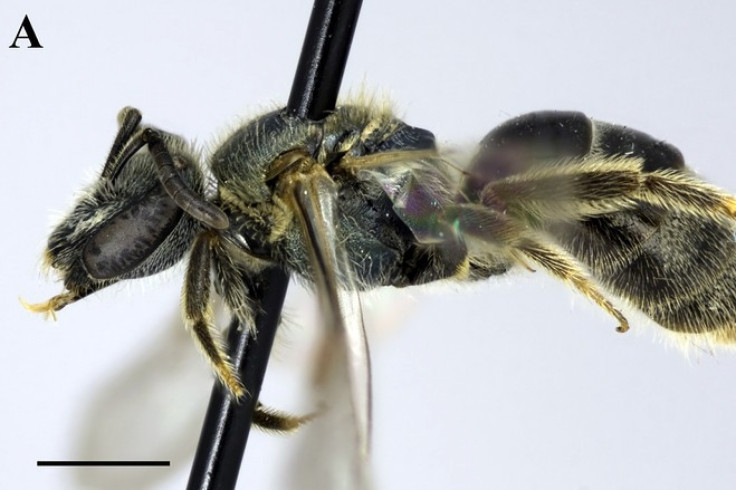New Bee Feeds On The Sweat Of New Yorkers

A new type of bee has made its home in New York City parks - and this one might be more attracted to post-workout bodies than it is fragrant flowers. The bee is a new species of sweat bee, a class of insects that feeds on the salty sweat of humans and animals, according to researchers at American Museum of Natural History and Cornell University.
Sweat bees are typically small, usually less than a half-inch long, and are found all over the world. While they still flit from flower to flower and pollinate just like other bees, they are attracted to human sweat, researchers said in a study published in the November issue of the journal Zootaxa.
They use humans as a salt lick, John Ascher, an entomologist from the American Museum of Natural history, who captured the first of the new species of sweat bee in 2010 in Brooklyn's Prospect Park, told the Wall Street Journal. They land on your arm and lap up the sweat.
Ascher oversees a digital catalogue of over 700,000 bee species but even after pouring over it, he still couldn't identify the bee he caught. A DNA test revealed that the bee was an unknown species -- so researchers gave it the name Lasioglossum gotham.
The bee has likely been feeding off park goers for years, Ascher said, but since it looks so similar to other bees, no one has ever bothered to see whether it is a different species.
Even until very recently, they've been impossible to identify because they're so small and they all look very similar, Ascher told the New York Times.
New York City is home to over 200 bee species, more than any other major city in the world, Ascher said. At least 49 of those species are sweat bees.
Sweat bees are relatively unobtrusive, according to Jason Gibbs, a bee researcher at Cornell University who coauthored the study alongside Ascher. While New Yorkers often see honeybees flying around, sweat bees take a lower profile.
You can have sweat bees nesting in your front yard and never know it because they are so small and mild-mannered, Gibbs told the Wall Street Journal. Hundreds can nest in a square meter of lawn.
Although they have a stinger, sweat bees only sting humans when provoked, according to the study. Swatting at, stepping on or trying to squash a sweat bee once it lands on you may make it attempt to sting you, researchers said. However, it gives up fairly quickly and usually does not chase its target.
Even if a sweat bee does sting you, its sting is relatively painless, rating a one out of four on the Schmidt Sting Pain Index, a scale used to measure how painful insect stings and bites are.
The sweat bee's sting is described by the scale as being light, ephemeral, almost fruity and feels as if a tiny spark has singed a single hair on your arm.
In comparison, a common honey bee sting is rated at two out of four and described as feeling as though you have been burnt by a match.
Most other bees only sting when provoked as well. However, other species are typically much more aggressive than sweat bees. If the animal feels its nest is threatened, it will actively seek out and attack anyone or anything it deems to be an intruder, often chasing its target. Killer bees will chase an intruder for up to a quarter mile, according to Columbia University.
The strongest sting on the Schmidt Sting Pain Index is that of the bullet ant, an insect only found in Brazil. Its sting is rated as a four and described by the scale as pure, intense, brilliant pain. Like fire-walking over flaming charcoal with a 3-inch rusty nail grinding into your heel.
The new bee species is the latest to be found on the streets of the Big Apple. In 2009, entomologists discovered a new species of cockroach in a Manhattan apartment and in March, researchers discovered a new species of leopard frog that calls Yankee Stadium home.
The findings bode well for the existence of new bee species in other parts of the country, Gibbs told the New York Times.
This study is really the tip of the iceberg, he said. If you consider that we are still finding species around one of the most well-studied metropolitan areas in North America, the prospect of finding new species in other parts of the country or other parts of the globe is just enormous.
© Copyright IBTimes 2024. All rights reserved.











